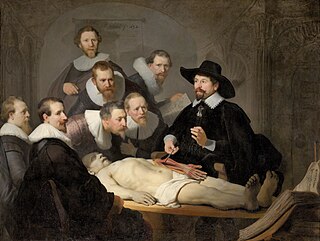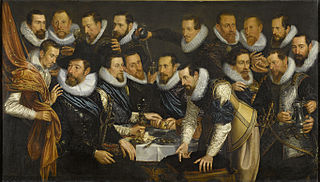The year 1641 in science and technology involved some significant events.

Joost van den Vondel was the Dutch national poet, as well as an essayist, and playwright. He is widely considered the best poet of the 17th-century Dutch Golden Age and the pinnacle of Dutch literature.

Joachim von Sandrart was a German Baroque art-historian and painter, active in Amsterdam during the Dutch Golden Age. He is most significant for his collection of biographies of Dutch and German artists the Teutsche Academie, published between 1675 and 1680.

Georg Eberhard Rumphius was a German-born botanist employed by the Dutch East India Company in what is now eastern Indonesia, and is best known for his work Herbarium Amboinense produced in the face of severe personal tragedies, including the death of his wife and a daughter in an earthquake, going blind from glaucoma, loss of his library and manuscripts in major fire, and losing early copies of his book when the ship carrying it was sunk.

Jan de Doot is the subject of a painting from 1655 by Carel van Savoyen. It shows De Doot, a smith, holding in one hand a kitchen knife, and in the other a large bladder stone the size and shape of an egg, set in gold. This 17th-century Dutch blacksmith is said to have performed a successful lithotomy on himself in 1651. The painting is part of the Portrait Collection of the Laboratory of Pathology, which is part of the University of Leiden.

The Anatomy Lesson of Dr. Nicolaes Tulp is a 1632 oil painting on canvas by Rembrandt housed in the Mauritshuis museum in The Hague, the Netherlands. It was originally created to be displayed by the Surgeons Guild in their meeting room. The painting is regarded as one of Rembrandt's early masterpieces.
Dutch Renaissance and Golden Age literature is the literature written in the Dutch language in the Low Countries from around 1550 to around 1700. This period saw great political and religious changes as the Reformation spread across Northern and Western Europe and the Netherlands fought for independence in the Eighty Years' War.

Nicolaes Tulp was a Dutch surgeon and mayor of Amsterdam. Tulp was well known for his upstanding moral character and as the subject of Rembrandt's famous painting The Anatomy Lesson of Dr. Nicolaes Tulp.

Albert Coenraadsz. Burgh was a Dutch physician who was mayor of Amsterdam and a councillor in the Admiralty of Amsterdam.

Jan Six was an important cultural figure in the Dutch Golden Age.

Nicolaes Witsen was a Dutch statesman who was mayor of Amsterdam thirteen times, between 1682 and 1706. In 1693 he became administrator of the Dutch East India Company (VOC). In 1689 he was extraordinary-ambassador to the English court and became Fellow of the Royal Society. In his free time, he was cartographer, maritime writer, and an authority on shipbuilding. His books on the subject are important sources on Dutch shipbuilding in the 17th century. Furthermore, he was an expert on Russian affairs. He was the first to describe Siberia, the Far East and Central Asia in his study Noord en Oost Tartarye [North and East Tartary].

Jan Jansz. Vos was a Dutch playwright and poet. A glassmaker by trade, he also played an important role as stage-manager and director of the theatre. He organized, on the mayors' orders, processions and splendid decorated floats, which sometimes drew disapproval, criticism, and derision.

Dirck or Diederik Tulp (1624–1682) was the son of the surgeon professor Nicolaes Tulp and involved in the Dutch East India Company and the Civic guard. Dirck Tulp visited Moscovia with his father-in-law; he was painted in 1653 by Paulus Potter.

Geurt van Beuningen (1565–1633) was a Dutch Golden Age merchant and burgomaster of Amsterdam who was one of the founders of the Dutch East India Company.

Carel van Savoyen or Carel van Savoy (1620/21–1665) was a Flemish painter, draughtsman and printmaker who was active in Antwerp and Amsterdam. He is mainly known for his history paintings and portraits but he also painted allegories and genre scenes.

Witsen is a patrician family of Amsterdam. Its most notable member was the politician and scholar Nicolaes Witsen, but many other members of the family also held leading roles in trade and politics from the Dutch Golden Age up until the French occupation of the Netherlands in the late 18th century.

Nicolaes Hasselaer, was a Dutch Golden Age brewer and major of the Amsterdam schutterij, who is best known today for his portrait by Frans Hals.

View of Bentheim Castle is an oil on canvas painting of Burg Bentheim by the Dutch landscape painter Jacob van Ruisdael. It is an example of Dutch Golden Age painting and is now in the collection of the Rijksmuseum.

Wendela Bicker was the wife of Johan de Witt. She was one of the richest young female commoners of her time and she married one of the most influential republican politicians in the Netherlands. She was in the public eye during her lifetime and entered history books thereafter. This is facilitated by the letters and the housekeeping books she left behind. The narrative about her life reflects how the role of women in the Netherlands in the 17th century was and is understood.




















